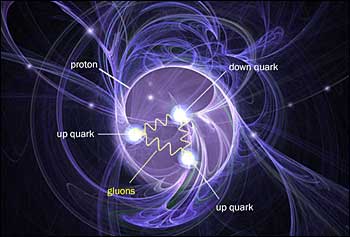The Relationship Between Quark Matter and the Higgs Boson
You might believe that you’ve already encountered all the essential information about the origin of mass. After all, scientists at the Large Hadron Collider (LHC) in Europe recently provided compelling evidence suggesting the existence of the Higgs boson, a long-sought particle believed to “impart mass to matter.” However, while the Higgs particle may be responsible for the mass of fundamental particles like quarks, quarks alone cannot explain the mass of the majority of visible matter in the universe—the entirety of what we observe and perceive around us.
To comprehend what binds together these observable forms of matter, encompassing everything from stars and planets to people, one must delve into the interactions between quarks and gluons. This constitutes the core of quark matter physics, a field explored at the Quark Matter 2012 international conference held in Washington, D.C., from August 12 to 18.

“We’re investigating the 99 percent of the mass of the visible universe that isn’t explained by the Higgs,” explains Peter Steinberg, a physicist at the U.S. Department of Energy’s Brookhaven National Laboratory and an active participant in the Quark Matter conference. Visible matter, he clarifies, comprises everything composed of atoms, deriving its mass primarily from the protons and neutrons constituting atomic nuclei. The orbiting electrons contribute minimal mass. However, protons and neutrons, each comprising three quarks, exhibit a much greater mass than the combined mass of their constituent particles.
The question arises: where does this “extra” mass originate? Physicists believe the answer lies in how quarks interact through the exchange of gluons—massless particles that bind quarks together via nature’s strongest force—and interactions among the gluons themselves. To unravel the characteristics of this force, which intensifies when attempting to separate subatomic quarks, physicists accelerate atomic nuclei (or heavy ions) to nearly light speed.
At this velocity, gluons become predominant, and the nuclei are directed into head-on collisions at particle accelerators such as the Relativistic Heavy Ion Collider (RHIC) at Brookhaven and the Large Hadron Collider in Europe. These collisions recreate conditions that prevailed early in the universe, before quarks combined to form protons and neutrons. Analyzing the behavior of “free” quarks and gluons in this primordial quark-gluon plasma should aid scientists in comprehending the strong force and how it generates a significant portion of the mass observed when particles unite to form ordinary matter. Therefore, even though visible matter constitutes only a fraction of the total universe—merely five percent, with the remainder composed of dark matter and enigmatic dark energy—it provides ample material to engage physicists like Steinberg for an extended period!
This article is republished from PhysORG under a Creative Commons license. Read the original article.
Do not forget to share your opinion with us to provide you with the best posts !



0 Comments